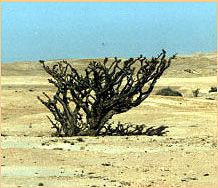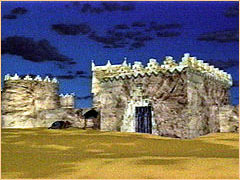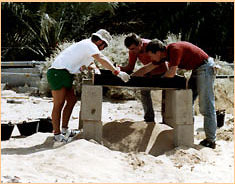 |
 |
NOVA: Does the pottery tell you anything about how the Ubarites lived?
JZ: Well, we know how they lived from day to day because we've got the bones
and vegetable remains that have been analyzed by the people at the British
Museum of Natural History. But the interesting part is they seem to have had
an outpost out here that tied in a whole network of outposts that linked
together a region—either trading in Frankincense and Myrrh or trading in
Arab horses—all of them seemed to be good candidates. We hadn't suspected
that.
NOVA: They traded in horses too?
JZ: Later on in medieval times, there are accounts that say that they
continued to trade horses out of this region onto the coast and then shipped
them to India. And since we do have this link now with India on this pottery,
it seems to be that maybe that's one of the other products that they traded out
of here.
 NOVA: Did you find storage vats for the frankincense at Shisur? NOVA: Did you find storage vats for the frankincense at Shisur?
JZ: We didn't find vats at Shisur. But we actually found pieces of
frankincense—little crystalline forms. The vats were found at another site
further to the east. So there definitely were storage facilities in this
region.
NOVA: Can you tell us more about the satellite campsites around the town?
JZ: At the time of Ubar, you had nomadic groups moving across the region in
the form of caravans. Remember, this is pretty remote out here in terms of
water resources. So the caravans are traveling from station to station. The
site that we uncovered at Shisur was a kind of fortress/administration center
set up to protect the water supply from raiding Bedouin tribes. Surrounding
the site, as far as six miles away, were smaller villages, which served as
small-scale encampments for the caravans. An interesting parallel to this are
the fortified water holes in the Eastern Desert of Egypt from Roman times.
There, they were called "hydreumata." Steve Sidebotham of the University of
Delaware and Sharon Hebert have done work on this.
NOVA: What do you make of the thick walls and towers at the Shisur site? Do
they indicate that this was a hostile environment?
 JZ: Thick walls and towers are generally put in place because of a hostile
environment. We know from present day activity that any permanent source of
water is always under threat in the desert. Plus they would have had money in
there, because they were conducting trade in frankincense and what have you.
And so there was always a temptation to rob people. JZ: Thick walls and towers are generally put in place because of a hostile
environment. We know from present day activity that any permanent source of
water is always under threat in the desert. Plus they would have had money in
there, because they were conducting trade in frankincense and what have you.
And so there was always a temptation to rob people.
NOVA: What evidence did you find of the practice of agriculture at the Shisur
site?
JZ: We recovered the bones of domestic animals—cattle, for example. Even,
and I hate to say this, pig (laughs)—of course, absolutely outlawed today—sheep and goats—fish brought in from the Indian ocean. And then we got
indirect evidence by finding grinding stones for plants like barley and dates,
which are traditional to the area.
NOVA: How could they have grown anything?
JZ: They had the water, which went out into an irrigation scheme. When
Bertram Thomas came through there in the 30's and Thesiger in 40's, he remarked
upon the presence of faint field lines, which are now destroyed as a result of
modern activity.
NOVA: Why did such an amazing site remain undetected for so many years?
 JZ: Well, the site had just almost completely disappeared under dirt and rock
and sand. So, for years, people used to say well there's nothing there but a
little tiny observation post that was put in there about 200 years ago. People
wrote it off and said there's nothing there. JZ: Well, the site had just almost completely disappeared under dirt and rock
and sand. So, for years, people used to say well there's nothing there but a
little tiny observation post that was put in there about 200 years ago. People
wrote it off and said there's nothing there.
NOVA: Were the pottery shards the clue that led you to believe this might not
be the case?
JZ: Yeah. We began to walk around there and find pottery shards that were
definitely not Islamic in date. So, to me, it indicated that the site was
either classical or Iron Age or something. Something different.
NOVA: What are the challenges of pulling off an archaeological dig in the
middle of the Omani desert?
JZ: Logistics are the biggest problem. The idea that you have to bring people
out there. They need somewhere to stay. You have to feed them. Fortunately,
the Bedouins, with the help of the government of Oman, provided us access to
some of the new houses that they had built out there, so we actually were able
to stay on site. Our food, however, came from an hour or two away, depending
on where we went.
(continued)
Lost City Home | Remote Sensing | Interview | Desert Finds
Artifact Gallery | Map | Links
|
|
|